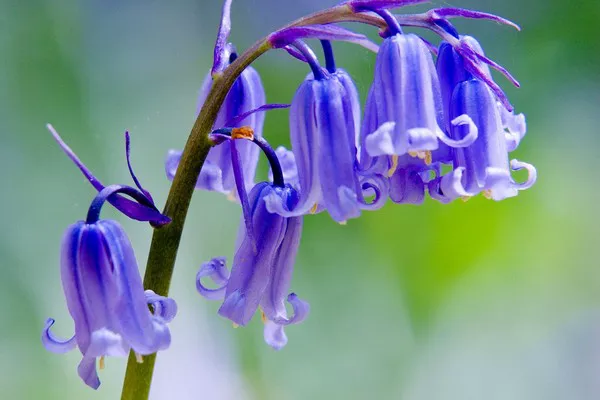Flowers have long captivated human hearts with their varied shapes, colors, and fragrances. Among the myriad forms that nature has bestowed upon them, bell-shaped flowers stand out for their unique charm and distinctive appearance. These exquisite blossoms, as the name suggests, resemble the graceful silhouette of a bell and hold a special place in the world of botanical wonders. In this article, we will delve into the captivating realm of bell-shaped flowers, exploring their characteristics, significance, and some noteworthy examples, while also touching upon their pollination strategies and cultural symbolism.
The Allure of Bell-Shaped Flowers
Bell-shaped flowers, scientifically known as “campanulate” flowers due to their bell-like structure, possess a distinct shape characterized by a flaring rim and a narrow tube that opens into a wider, often rounded, base. This unique form not only makes them visually striking but also serves specific ecological and reproductive functions. The flared rim often acts as a landing platform for pollinators, while the narrow tube ensures that only certain pollinators, adapted to the flower’s shape, can access the nectar within.
Diversity in Shape and Size
Despite their shared bell-like appearance, these flowers exhibit a wide array of sizes, colors, and adaptations. From delicate hanging bells to more upright and open structures, the bell shape can vary greatly. Flowers like the Canterbury bells (Campanula medium) are large, showy examples, while plants like the lily-of-the-valley (Convallaria majalis) feature dainty and fragrant pendant bells.
Pollination Strategies of Bell-Shaped Flowers
The unique shape of bell-shaped flowers often aligns with specific pollination strategies. Many of these flowers are adapted to attract certain pollinators, such as hummingbirds, butterflies, or specific bee species, that can easily access the nectar within. The flared rim provides a platform for these pollinators to land, while their long tongues or proboscises can reach deep into the narrow tube to extract nectar. This selective pollination mechanism can lead to strong relationships between bell-shaped flowers and their pollinators, contributing to the diversity and beauty of both the floral world and the insect world.
Cultural and Symbolic Connections
Throughout history, bell-shaped flowers have held cultural significance and symbolism in various societies. In some cultures, they are associated with purity, humility, and gratitude. For instance, the Lily-of-the-Valley is often linked to the idea of humility and is considered a symbol of the return of happiness. In other cultures, these blossoms might signify luck, renewal, or even protection against negative energies. The bell shape’s association with protection is evident in the use of certain bell-shaped flowers in traditional rituals or as ornamental plants around homes.
Noteworthy Bell-Shaped Flowers
1. Lily-of-the-Valley (Convallaria majalis)
The Lily-of-the-Valley, a classic example of a bell-shaped flower, is known for its sweet fragrance and delicate appearance. Native to Europe, Asia, and North America, this flower’s tiny, drooping white bells make it a popular choice in bridal bouquets and garden borders alike.
2. Canterbury Bells (Campanula medium)
With its stately spikes adorned with large bell-shaped flowers, the Canterbury Bells plant is a biennial that commands attention. Originating from Southern Europe, it comes in various hues, including blue, pink, and white. Its showy nature has made it a favorite in cottage gardens.
3. Trumpet Vine (Campsis radicans)
The Trumpet Vine produces stunning, trumpet-shaped flowers that can also exhibit a bell-like appearance. Native to the southeastern United States, this vigorous climber is known for its vibrant orange-red blossoms that attract hummingbirds and bees.
4. Bluebell (Hyacinthoides non-scripta)
Native to Western Europe, the Bluebell boasts charming drooping bells that dominate woodlands in springtime. These nodding, bell-shaped flowers create carpets of blue that are a sight to behold and are often associated with ancient forests.
Planting Considerations
If you’re interested in cultivating bell-shaped flowers, it’s important to consider their specific needs. While the requirements vary based on the species, most bell-shaped flowers thrive in well-draining soil with adequate sunlight. It’s advisable to research the specific needs of the chosen flower to ensure a successful cultivation process.
Garden Design
Incorporating bell-shaped flowers into your garden design can add an element of elegance and whimsy. Their unique shape can be used to create visual interest when combined with other flower forms. Planting them strategically along paths or borders can guide the viewer’s gaze and create a sense of movement in the garden.
Conclusion
Bell-shaped flowers, with their distinctive form and intricate adaptations, exemplify the fascinating diversity of the botanical world. From their pollination strategies to their cultural symbolism, these blossoms provide a window into the complex relationships between plants, pollinators, and humans. Whether adorning gardens, bridal arrangements, or cultural rituals, bell-shaped flowers continue to capture our admiration and remind us of the intricate beauty that exists in nature’s tapestry. As you explore the world of botany, take a moment to appreciate the grace and allure of these bell-like wonders that enrich our lives with their presence.


